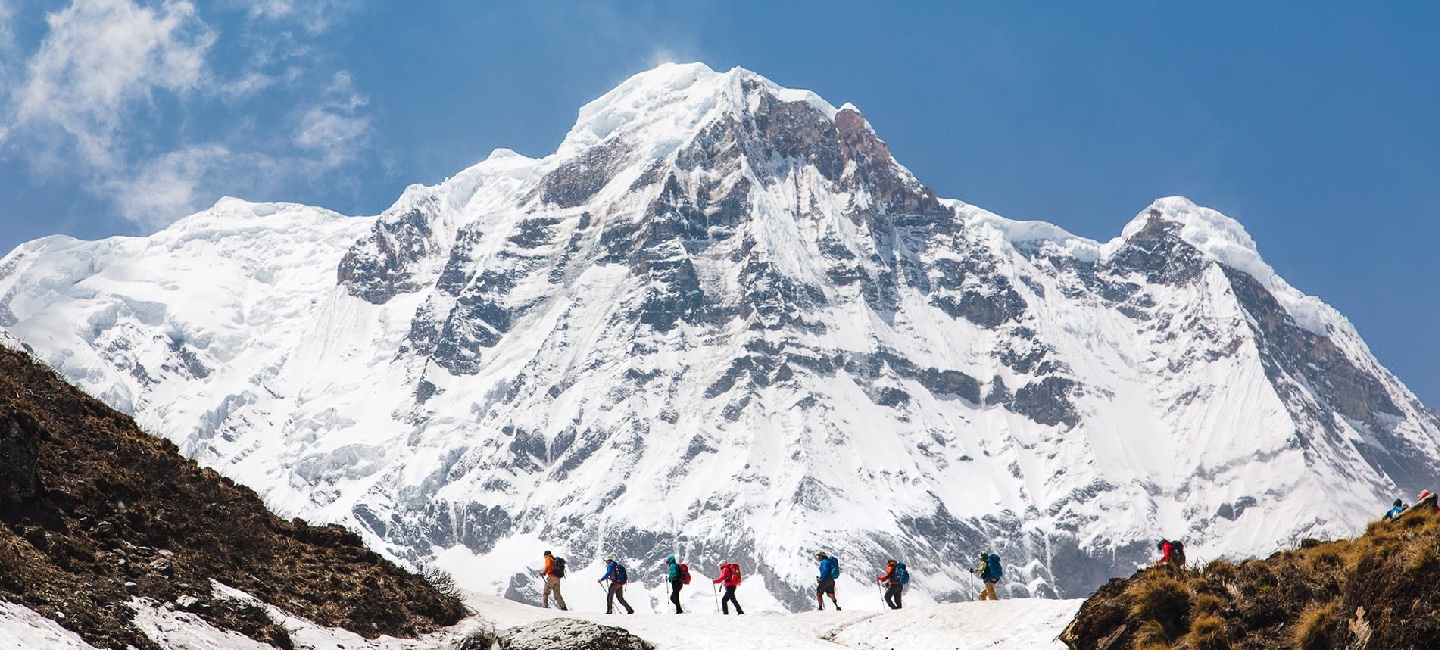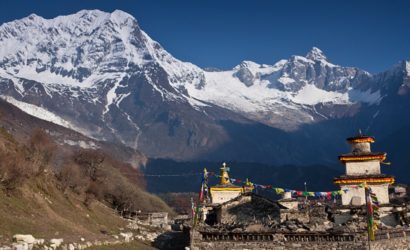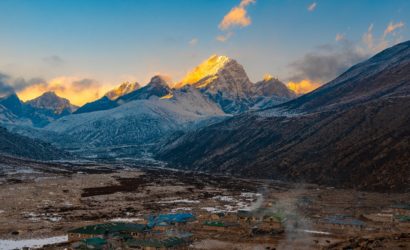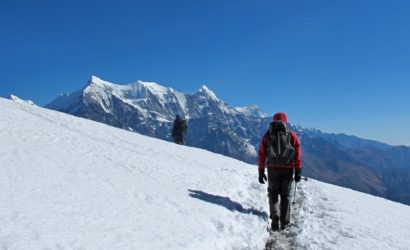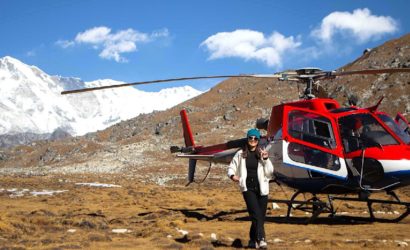The Annapurna Base Camp Trek is one of the best treks to discover the mountain range, with the foremost spectacular mountain scenery, providing a desirable insight into the fashionable hill life of Nepal.
This is a unique trek on local trails, through forests, villages and terraced farmland treats you to unique mountain scenery, surrounded by huge glaciers providing you with an indoor experience into the Nepalese life and culture.
12 Days, Annapurna Base Camp follows the Modi-river and passes through the dense undergrowth of rhododendron and bamboo. By the time you reach the massive rock overhanging, called Hinku Cave, noticed that the vegetation has cut and therefore the gorge narrowed to be only a couple of hundred meters wide.
Steep snow-covered ridges falling from Hiunchuli on the left and Machhapuchhre on the right from the doorway to the Sanctuary. As we go through the “gate” and enter to the Sanctuary, you discover yourself in a very large amphitheatre encircled by a solid wall of natural covering peaks.
The trek starts from Pokhara with a drive of about 1 hrs by taxi or jeep ride to Nayapul then we will start our journey towards Annapurna Base Camp via passing Poon Hill which is one of the popular short treks in Nepal offering views of Annapurna South and Machhapuchhre.
If you are short on time and find that 12 days is still too long, the Poon Hill Trek is another good alternative, and it can be done in as little as 3 to 4 days offering wonderful views of the Annapurna Range. The Annapurna Base Camp Trek can be in 8 to 12 days.
12-Day Annapurna Base Camp Trek: Highlights
- Starting and ending in Kathmandu, discover Nepal’s capital-rich cultural and artistic heritages.
- The perfect first Himalayan trek through classic high mountain scenery.
- The breathtaking world-class Himalayan scenery from a heavenly viewpoint.
- The natural beauty of the ancient rhododendron forests and the natural hot springs.
- Highly experienced Sherpa leaders.
Upon your arrival in Kathmandu airport after completing your custom formalities Visa, etc. pick up your luggage and look for our airport representative from Himalaya Discovery, who will display your name on the board at the arrival gate. You will be greeted by our representative and transferred to your hotel by private tourist vehicle.
Today is free for sightseeing in Kathmandu. You may wish to visit Durbar Square in the heart of the old city where the old Royal Palace, with its intricate woodcarving is located. The whole area is a maze of temples and images. Leading away from the square in all directions are narrow alleys, full of the most amazing variety of shops and stalls.
Some of these landmarks are considered World Heritage Sites including the historic Bhaktapur Durbar Square, the famous ‘Monkey Temple’ Swayambhunath and Buddhists shrine Boudhanath which is one of the largest Stupas in the world.
There will also be a full trip briefing today with gear check. In case you need to hire or buy equipment locally, there will be time to do this today.
Your guide will pick you up at 6:30 am from the hotel and take you to the tourist bus station. The bus leaves to Pokhara at about 7:30 am. Also known for its panoramic views of Annapurna and Machapuchare (Fishtail) in the north, Dhaulagiri in the west and Lamjung Himal and Manaslu in the south, Pokhara is a lovely valley on the banks of the Phewa Lake. Overnight at hotel in Pokhara.
We begin our trek at Nayapul after 1-hour driving by private vehicle from Pokhara. After 15 minutes short walk along the banks of the Modi Khola, we reach Birethanti (1015 meters) a large village that has many shops and teahouses. From there, the trail continues through the village.
The trail follows the north bank of the Bhurungdi Khola. The trail climbs steadily up the side of the valley to Hille at 1495 meters and after the short climb, we reach Tikhedhunga at 1570 meters.
Today’s walk offers a short and relatively easy day, during the journey allowing to get use to the experience of trekking in Nepal. Overnight at guesthouse.
Leaving Tikhedunga, we begin our journey with a steep climb to Ulleri. Ulleri is a large Magar village at 2070meters. The trail then continues to ascend more gently, through fine forests of oak and rhododendrons towards Banthanti at 2250meters. Then we trek towards Nangethanti at 2460meters. After an hour walk, we arrive at Ghorepani at 2840meters. Overnight at guesthouse.
Today, very early in the morning, we start an hour hiking to Poon Hill at elevation of 3210 meters, a brilliant spectacle; this vantage point provides an unobstructed view of the sunrise over the high Himalayas.
There we spend about 1 hour, then returning to Ghorepani we take a hot breakfast at a hotel. Leaving Ghorepani, we make climb along ridges, and through pine and rhododendron forests to Deurali (2960 meters). After that, we descend to the Banthanti, then turning off to Tadapani. Overnight at guesthouse.
The day starts with steep downhill through rhododendron forests. Leaving Tadapani, we descend steeply through forests and then the trail eases as we reach Gurjung which is the village of Gurung people, with an easy walk to Chommrong at elevation of 2140 meters. Overnight at guesthouse.
Today the trail drops down to the Chhomrong Khola and again we continue climbing to Khuldighar at 2380meters where there used to be an ACAP (Annapurna Conservation Area) check post.
There is a clearing in the forest a little further on, from which, the route travels very steeply down a rock bank then levels out, running through thickets of bamboo at the bottom of the gorge, keeping always on the west side of the river. Overnight at guesthouse.
A short walking day today because of altitude and risk of snow avalanches in the area that we need to cross in the next morning. Our day begins with the climb through bamboo, then rhododendron forests to Himalayan Hotel and on to Hinko cave. The accommodation will be in Deurali, on the ridge above Hinko is the stretch of trail that is most subject to avalanche. Overnight at guesthouse.
Today the trail climbs on past the Machhapuchhare Base Camp, which isn’t really a base camp since climbing the mountain is not permitted. Since it is totally surrounded by mountains, this area is known as the Annapurna Sanctuary.
Two hours trek from Machhapuchhare Base Camp takes you to the Annapurna Base Camp (ABC) at elevation of 4130 meters. There, you will view unobstructed views of mountain scenery, which is very spectacular. Overnight at guesthouse.
We follow the same trail down today the trail drops down by 1700meters to the bank of Modi Khola to Bamboo at 2345meters where there are few teahouse / lodges available to stay at, Overnight at guesthouse.
We follow the same trail until Chommrong. Once we have passed Khuldighar there is an experimental sheep farm, the trail continues through rhododendron and bamboo fields.
From Chomrong the trail descending very steeply to the Jhinu hot spring, where you can bathe in natural hot springs. Overnight at guesthouse.
From Jhinu hot spring we walk at the right side of Modi Khola for 4.30 hours to Birethanti which is considered one of the best and relaxing walk of the entire trek. We reach Nayapul then an hour drive will take us back to Pokhara. Overnight at hotel.
We depart at approximately 7.30 am for Kathmandu by tourist bus. We arrive back in Kathmandu at around 2-3.00 pm.
Today is rest and relax throughout the day. If you get interested to take some gifts from Nepal for friends and relatives, visit some nearby shops or go out in Thamel for typical Nepalese goods.
In the evening we will have a farewell dinner in a traditional Nepalese restaurant with cultural performances. The farewell dinner will be host one day before your departure from Nepal.
The trip concludes, we will drop you to the airport for your flight departure from Nepal.

